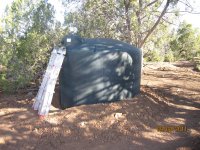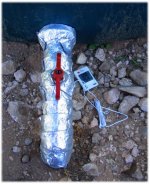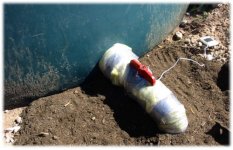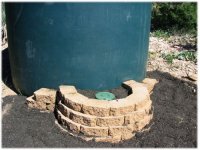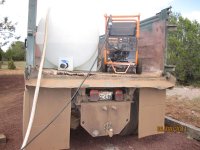It is a small world. We have a place that we go to in the summers near there, up at 7500 feet, technically in New Mexico. Some tips that have helped me:
1. I have 3 approx 200 watt panels mounted flat on top of a storage box that provide us with enough electricity to run a portable evaporative cooler during the afternoons, plus t.v. and such. The grid-tie panels that I bought are cheaper, and the Outback 60 charge controller has MPPT voltage conversion to bring it down to 12v for my 4 sam's club golf cart batteries (series/parallel). Just put a a 10 amp fuse on each panel wire, and they all parallel into the controller, since they're all similar voltage. I use a 175 watt RV resettable inline circuit breaker going to the inverter from the batteries, and regular 15 amp breakers going to the trailer and water pump from the inverter.
2. I use a Xantrex prosine 2.0 (pure sine wave) inverter/charger which powers everything, including my wife's hair dryer, a toaster, microwave, and grundfos water pump. You can add another and they will synch to give 240v, so they are very economical, plus expandable. I put an extension cord male plug coming out of the Xantrex which allows me to plug into a small gas generator in case of snow/overcast/rain to charge up the batteries. We use the high draw items during the afternoon and the batteries are topped back up very quickly.
3. I use a 100watt panel with 2 sam's club batteries to power the 12v coach items, which includes the switching for the refrigerator control, water heater control, all the interior lights, and the furnace fan.
4. We use portable lp gas cylinders, the 30 pound size being a good compromise. I put pressure gauges on them, but lifting them gives me a better indication of when they're running low or not.
5. We also bought a 40' container for our machines. I highly recommend using solar chargers on all batteries....but you must use the type with controllers. Battery tender now makes a 5 watt panel with float charge controller, unlike those cheaper panels that don't know when to slow down, this will keep the battery at 13.2 volts after charging. Glue them to the top of the container, drill a tiny hole through the little vents in the upper corners, then cut the wires, resplice the connectors on the inside, and you will not be buying batteries very often.
6. I have the same water tank, about half submerged. We add bleach every year, and it has lasted a long time, but does smell like chlorine, which doesn't bother us.
7. I took out the toilet and black water tank immediately, then installed a tight clearance residential toilet (has thinner tank dimensions, so it doesn't stick out far from the back wall), then ran straight pvc pipe to the septic, with a Y for the output of the gray water tank to join it (downhill from the gray water level, to avoid them mixing in the graywater tank). This gives no smell, no residue in the black water tank, which is almost a certainty if you leave the outlet open all the time, due to the large area vs. small amount of water per use.
8. We try to not drive when it's wet, since the calichi mud is so gunky, as you've found out, I'm sure.
9. It's too long of a trip for me to get out there from Florida very often, so I envy you building your place. My solar setup allows any power tools to run, including air compressor, so I look forward to hearing how you handle your building.....I hope to do something similar myself, possibly with a pole-barn type foundation and built-up wood floor.
10. I have a motorgrader that I inherited, needs a tire fixed, will sell pretty cheap, Cat 12, I think, as well as a Fiat/Allis FL-5 track loader with a 4-way bucket that is a lot of fun.
11. If there is a market for tumbleweed, I can also claim my expenses as a deductible item!
12. I used to do a lot of gravel drive maintenance, and a box blade can really help for spreading dump loads.
